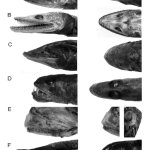I seem to develop these weird, unfounded hatreds of various things. For example: I hate blue dinnerware. Not every shade of blue dinnerware (I LOVE prussian blue glassware), but I severely dislike those particular gray-blue shades reminiscent of country Americana. I can’t explain it–the mere sight of plates like these makes me angry. I would rather eat off the floor than eat off blue stoneware. If I could represent my ultimate nemesis in kitchenware, it would be blue gingham cloth napkins. Ick.
My opinions are similarly skewed across the Tree of Life. We all know I love nematodes. Protists are really weird, and therefore really cool. Algae can hold my interest. But I really can’t stand plants. I feel so guilty about this, because I’ve learned so many awesome things about plants over the years. Every time I learn a new fact, I reevaluate my reasons for shunning leafy species and commit to do some more reading. And then I get bored. I guess its kind of like reading unabridged Victor Hugo–you know you really should sit down and read classics like Les Miserables and The Hunchback of Notre Dame, but trying to persevere through Hugo’s hundred-page architectural descriptions is just so…tedious.
At my inaugural Eisen lab meeting in UC Davis last month, I had an epiphany: I FINALLY found a plant I liked
Seagrasses are unabashedly awesome.

These marine species are kind of like the nematodes of the plant kingdom: they might not be the most well known group, but they can be used as model organisms to investigate the Big Questions in biology and evolution.
Seagrasses are also the whales of the plant kingdom – extant aquatic species came from terrestrial ancestors that, over time, walked back into the sea (since before that, we think all life originally spawned from a primordial ocean). Like nematodes, it wasn’t just one hipster seagrass group that decided continental life was “too mainstream”. Re-entering marine habitats happened independently in at least three separate branches on the seagrass tree of life.
Moving from the land to the sea doesn’t just happen. If it did, we’d all be Aquaman. But nope, Aquaman’s abilities stem from the fact that he is some weird genetic mutant (Sidenote: The whole story of Aquaman presents some serious ethical concerns, since he appears to be the by-product human experimentation from his own FATHER: “.. By training and a hundred scientific secrets, I became what you see — a human being who lives and thrives under the water“. I don’t even want to know what kind of lab chemicals he was cajoled into ingesting).
In seagrasses, gene changes must also have occurred for these plans to live in marine environments. Think about it – even if you kept your head above water (breathing oxygen), you couldn’t live life with your whole body submerged in the ocean. Your skin cells are dependent on exposure to air, and I imagine that briny bath would get pretty painful after a while.
Water bends light. And seagrasses are one plant group that needs a lot of light. Species must deal with the lower intensity of underwater light, as well as the shift in proportions of different wavelengths that penetrate the ocean surface.
The sea is also salty. At the level of cells and tissues, a huge array of basic molecular processes are controlled by the flow of sodium and potassium ions across membranes. Certain ions like potassium are also a critical ingredient for enzymatic reactions governing protein synthesis and ribosome function. For non-adapted species, seawater can be a poisonous broth, fatally disrupting these basic cellular processes. Marine species must possess specific adaptations to grow and thrive amongst high environmental levels of salt.
Surprise #3, the ocean has waves. Flimsy grasses must be able to hold their ground. Tides and currents also impact reproduction (you don’t want all your gametes to float away) and photosynthesis (a reduced availability of carbon dioxoide).
So life in the sea required seagrasses to address some serious issues that would otherwise be very detrimental to essential biological processes. Remember that three different groups of seagrasses did this on three separate occasions – for us modern day scientists, this has provided a seriously elegant look into the exact genetic modifications that are critical for adapting to life in the ocean.
Strikingly, despite their independent evolutionary routes, seagrasses from the three different lineages have evolved many similar morphologies, life history strategies, and breeding systems [3,18]. This indicates that the aquatic habitat imposes novel selection forces that can lead to parallel evolution. [Wissler et al. 2011]
Which is pretty awesome.
In a recent study, Wisslet et. al (2011) wanted to take things to a whole other level and look for candidate genes that helped seagrasses survive life in a marine environment. They focused on identifying adaptive mutations in conserved (orthologous) protein-coding genes also present within the genomes of their terrestrial plant relatives. [Although it was not applied in this study, environmental adaptation can also be studied in the context of changes to gene expression, e.g. the same set of genes used in different ways across tissues and life stages]
Reverting to a marine life showed a noticeable impact on 51 seagrass genes. Note that these kind of comparative studies are restricted to genes that share a common ancestry; in this case, the seagrass study only looked at 189 gene clusters, equivalent to glimpsing at only ~1% of an entire genome.

Now the results of this study aren’t particularly surprising–the pathways for marine adaptation are pretty logical–but this study perfectly showcases the POWER OF GENOMICS (please invoke Darth Vader voice there).
…photosynthesis, a few metabolic pathways, and ribosomes have strongly diverged after the split of the common ancestor of seagrasses from terrestrial monocots. Further studies will need to address the following questions: (1) How seagrasses have acquired osmoregulatory capacity to tolerate high salinities, (2) how CO2 is fixated, (3) how their photosynthetic apparatus has evolved for under water light harvesting, and (4) under what conditions anaerobiosis takes place. [Wissler et al. 2011]
The (comparatively) harsh marine environment, coupled with the action of natural selection, has caused seagrass genomes to diverge noticeably from their terrestrial ancestors. By promoting the survival of individuals that thrive in salt water, natural selection has, over time, tinkered with the cellular machinery for nutrient production and ribosome function. Additional tweaking has allowed seagrasses to deal with the different availability of gasses in the environment–for example, low oxygen availability in marine sediments (e.g. that disgusting pond muck smell if you start digging in an estuary) means that seagrasses can uniquely switch to fermentation instead of aerobic respiration if needed.
Seagrasses’ ancestors may have been a sputtering old tractor when they first tried to live in the sea, but modern-day species have evolved into a fine-tuned Lotus Exige. A beautiful, glorious machine that was contstructed on three separate occasions.
Reference:
Wissler et al. (2011) Back to the sea twice: identifying candidate plant genes for molecular evolution to marine life. BMC Evolutionary Biology 11:8 http://www.biomedcentral.com/1471-2148/11/8






I admit to a fascination with posidonia oceanica – neptune grass.
http://www.ibiza-spotlight.com/news/2006/monster_plant_280506_i.htm
Glad to see that you’ve come around, my dear. Perhaps now you’ve ascended to the state of readiness for the Zen of marine vegetation.
Emmett –
ZEN site = Best. Logo. Ever.
Seagrass rules!
“But I really can’t stand plants. ”
What a stupid thing to say.
Not particularly interested (who is interested in everything?) is one thing, but “hate” and “can’t stand”? What are you in middle school or something?
Golly gee, aren’t you edgy!